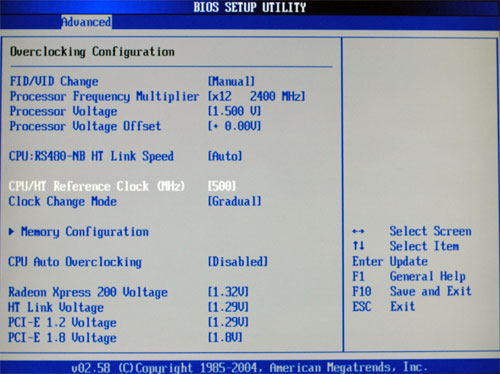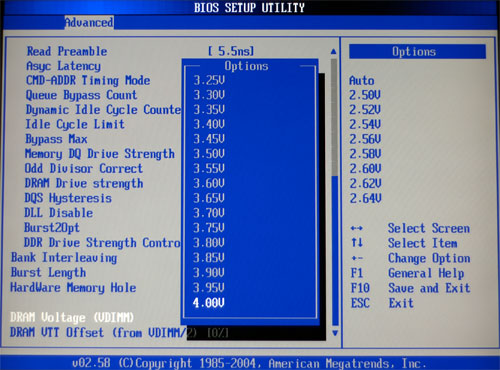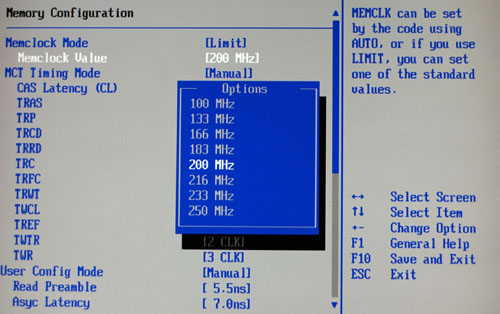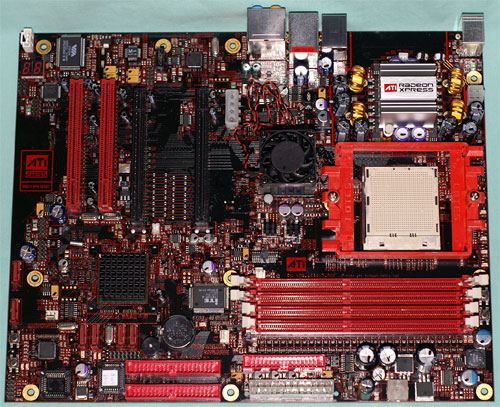ATI’s Crossfire: Best Overclocker on the Market?
by Wesley Fink on September 27, 2005 12:05 AM EST- Posted in
- CPUs
Basic Features: ATI Crossfire AMD Reference Board
It is almost heresy to call the options and adjustments on the Crossfire AMD "Basic Features", since they are clearly the best that we have ever seen on any AMD motherboard. The DFI nForce4 Ultra and SLI boards have quickly developed a reputation for offering the enthusiast every imaginable BIOS option. We mention the DFI only to put in perspective that the ATI offers 2 more memory adjustments not found on the DFI, a wider range of vDIMM to 4.0V, and even more controls to tweak the performance of the motherboard. It is clear that ATI has worked with a lot of enthusiasts in refining the Crossfire AMD - it shows in the depth and breadth of available options.
At the other end of the spectrum, ATI also offers automatic overclocking options in the BIOS for those uncomfortable with manual overclocking. You can dial in 1% to 15% overclocking and the board handles all the adjustments for you.
The ATI also has memory adjustments to DDR500 with the 4000+ Clawhammer processor that we use for standard benchmarking. The ability to run the processor at stock speed with memory at up to DDR500 opens new options for memory performance. You can do things like run the CPU at stock speed and the memory at DDR500.
Reference Boards are designed for qualification and we are certain that many would find the lack of any x1/x2 PCIe slots and just 2 PCI slots to be a concern if this were a production board. We saw a different slot arrangement on the Gigabyte ATI Crossfire AMD, and you will likely see many different slot configurations on production boards.
You may have noticed that the Gigabyte that we previewed several months ago controlled Crossfire with a "paddle board" similar to what we are accustomed to on NVIDIA. The AMD Reference Board does not use a paddle-card and all switching is done in the BIOS. In fact, the AMD Reference Board is capable of full auto-switching of single or dual video cards with no adjustments required in the BIOS if left in "Auto" mode. A number of video switching options are available to motherboard manufacturers.
| ATI Crossfire AMD Reference Board | |
| CPU Interface | Socket 939 Athlon 64 |
| Chipset | ATI RD480 Northbridge - ATI SB450 Southbridge |
| Bus Speeds | 200 to 500MHz in 1MHz Increments |
| Memory Speeds | DDR200,266,333,366,400,433,466,500 |
| PCIe Speeds | 100 to 200MHz in 1MHz increments |
| PCI/AGP | Fixed at 33/66 |
| Core Voltage | Auto, 0.825V to 1.55V in 0.025V increments PLUS .0V to 0.6V in 0.02V increments (Maximum vCore 2.15V) |
| CPU Clock Multiplier | 4x-25.5x in 0.5X increments |
| DRAM Voltage | Auto, 2.5V to 3.0V in .02V increments 3.0V to 4.0V in .05V increments (Maximun Memory Voltage 4.0V) |
| HyperTransport Frequency | 1000MHz (1GHz) |
| HyperTransport Multiplier | Auto, 1X to 5X |
| HyperTransport Voltage | 1.22V, 1.29V, 1.39V, 1.5V |
| Xpress 200 Voltage | 1.22V, 1.29V, 1.39V, 1.5V |
| PCIe 1.2 Voltage | 1.22V, 1.29 V, 1.39 V, 1.5V |
| PCIe 1.8 Voltage | 1.8V, 1.9V |
| Auto Overclocking | 1% to 15% |
| Memory Slots | Four 184-pin DDR DIMM Slots Dual-Channel Configuration Regular Unbuffered Memory to 4GB Total |
| Expansion Slots | 2 PCIe x16 2 PCI Slots |
| Onboard SATA/RAID | 4 SATA Drives by SB450 (RAID 0, 1, JBOD) 2 SATA II Drives by Sil 3231 |
| Onboard IDE/IDE RAID | Two Standard ATA133/100/66 (4 drives) |
| Onboard USB 2.0/IEEE-1394 | 8 USB 2.0 ports supported by SB450 2 1394 Firewire by VIA |
| Onboard LAN | Gigabit PCIe Ethernet by Marvel 88E8052 |
| Onboard Audio | Azalia HD Audio by Realtek ALC880 |
| BIOS | AMI Build 50 and Award Build 54 |
It is almost heresy to call the options and adjustments on the Crossfire AMD "Basic Features", since they are clearly the best that we have ever seen on any AMD motherboard. The DFI nForce4 Ultra and SLI boards have quickly developed a reputation for offering the enthusiast every imaginable BIOS option. We mention the DFI only to put in perspective that the ATI offers 2 more memory adjustments not found on the DFI, a wider range of vDIMM to 4.0V, and even more controls to tweak the performance of the motherboard. It is clear that ATI has worked with a lot of enthusiasts in refining the Crossfire AMD - it shows in the depth and breadth of available options.
At the other end of the spectrum, ATI also offers automatic overclocking options in the BIOS for those uncomfortable with manual overclocking. You can dial in 1% to 15% overclocking and the board handles all the adjustments for you.


The ATI also has memory adjustments to DDR500 with the 4000+ Clawhammer processor that we use for standard benchmarking. The ability to run the processor at stock speed with memory at up to DDR500 opens new options for memory performance. You can do things like run the CPU at stock speed and the memory at DDR500.
Reference Boards are designed for qualification and we are certain that many would find the lack of any x1/x2 PCIe slots and just 2 PCI slots to be a concern if this were a production board. We saw a different slot arrangement on the Gigabyte ATI Crossfire AMD, and you will likely see many different slot configurations on production boards.
You may have noticed that the Gigabyte that we previewed several months ago controlled Crossfire with a "paddle board" similar to what we are accustomed to on NVIDIA. The AMD Reference Board does not use a paddle-card and all switching is done in the BIOS. In fact, the AMD Reference Board is capable of full auto-switching of single or dual video cards with no adjustments required in the BIOS if left in "Auto" mode. A number of video switching options are available to motherboard manufacturers.












40 Comments
View All Comments
ShadowVlican - Tuesday, September 27, 2005 - link
well i hope i can buy the Xpress200.... ATi ain't real until i can buy their motherboards readily everywhere i go (like nVidia's NF4)Beenthere - Tuesday, September 27, 2005 - link
It's no secret ATI has the ability to produce equal or better chipsets and GPUs than Nvidia - they have done this before. What ATI needs to do is get their sh*t together on the details and CUSTOMER SERVICE - Yeah, they've heard of it but evidently they don't know the MEANING OF IT ! Nvidia ain't much better, but ATI's so called Customer Support is a bad joke. Delivering what you promise is a VERY IMPORTANT CONSIDERATION when you are charging the enthusists market segment El PREMO PRICES for your hardware and you had better DELIVER THE GOODS. ATI has failed miserably and Nvidia ain't far behind despite the fact both companies have reaped fortunes from the consumer enthusiast market. Until both companies improve their CUSTOMER SUPPORT neither are getting any of our corporate dollars.yacoub - Tuesday, September 27, 2005 - link
Okay so the first good vendor (Asus or similar) to come out with a passively-cooled northbridge, the ALC-880"D" audio chip, a Southbridge with better USB performance, and the rest (it can even be a single GPU board so it's under or around $100 in price) gets my money. =Pyacoub - Tuesday, September 27, 2005 - link
Okay that wasn't supposed to reply to your post. Interesting.Live - Tuesday, September 27, 2005 - link
Does ATI crossfire support NCQ hard drives or not? Have I understood it correctly in that it is not supported trough the 4 SATA ports from the Southbridge but you can get support from the 2 ports from the included Sil controller?I have read the http://www.anandtech.com/storage/showdoc.aspx?i=24...">What's in a name? SATA II Misconceptions
But I still fail to get the facts straight. Does a SATA 2 controller, either from a SB or separate like the Sli, support all of the capabilities in the SATA 2 specs as long as the hard drive does so?
Since I plan on going dual core next, no NCQ seems like a deal breaker to me.
Wesley Fink - Tuesday, September 27, 2005 - link
The SB450 Southbridge does not support NCQ. The ULi M1573, used on the retail Gigabyte Crossfire AMD and some upcoming retail boards, DOES support NCQ. The Silicon Image 3132 on the ATI Reference Board supports both NCQ and 3Gb SATA2 on the extra SATA ports.The just introduced ULi M1575 Southbridge, which can be used with the ATI Crossfire Northbridge (as soon as it hits the market) supports 3Gb SATA2, NCQ, PCIe Gigabit Ethernet, Azalia HD audio, and features competitive USB throughput. The ATI SB600 will also implement all these features.
etriky - Tuesday, September 27, 2005 - link
Anyone have some links to shed some light on this quote."There is a lot of discussion on the web these days claiming that you can minimize the impact of the 2T setting with certain options on Revision E AMD processors."
I've done some searches and come up with nothing.
Thanks.
bigtoe36 - Tuesday, September 27, 2005 - link
forcing a burst length of 8 and forcing burst2opt can bring back some of the lost performance going to 2T, both these features are on the crossfire reference board.Also, i mamaged to talk DFI into making a direct copy of the ATI reference that will run reference bios files, we should see this board in October. This board will be released along side the board already designed by Oskar...so you will have the choice of 2 CF boards from DFI.
Palek - Tuesday, September 27, 2005 - link
On page 1, 2nd paragraph the article says:"AMD had done a particularly excellent job targeting the enthusiast for the new chipset launch, but that realization seemed to come late in the chipset development process."
I suspect that AMD should be ATI.
On page 3, 1st paragraph:
"AMD Crossfire" first, then "Crossfire AMD" later. "ATI Crossfire" or "ATI Crossfire AMD" may be less confusing.
Also on page 3, in last paragraph "AMD Reference Board" is used twice, but the board is referred to earlier on in the article as the "ATI Crossfire AMD Reference Board". "AMD Reference Board" makes it sound like AMD made it.
Question:
How hot did the northbridge get during various phases of your testing? I think a lot of users would appreciate some info regarding operational temperatures. If the ATI chipset turns out to run a lot cooler than nForce4 chipsets, I will gladly forgive the USB speed problems and go with an easier to cool motherboard.
Wesley Fink - Tuesday, September 27, 2005 - link
Corrected.See other comments for NB heat and cooling. My subjective observation is the ATI Northbridge is cooler during heavy OC than the nF4 under the same conditions. However, many of you push boards a lot further than I do so you can take that with a grain of salt. ATI designed this board for the enthusiast and extrene overclocking and temperature under stress was a definite design consideration.